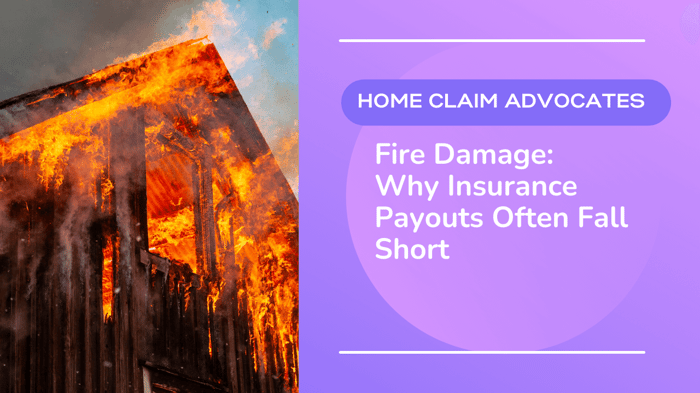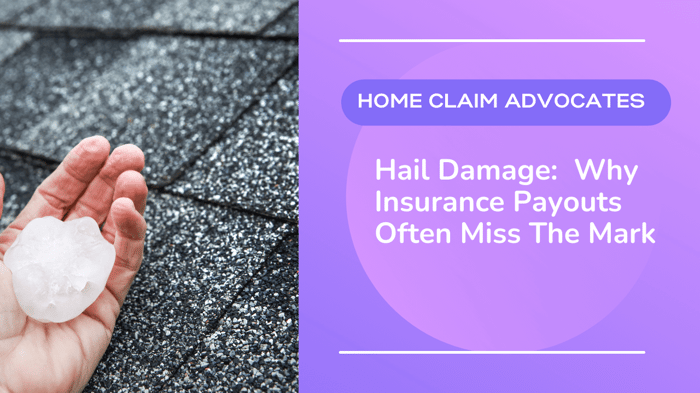Table of Contents
Navigating the Insurance Claims Process: What Homeowners Need to Know
Filing a homeowners insurance claim can feel overwhelming, especially after experiencing unexpected damage to your property. The insurance claims process is supposed to help policyholders recover, but in reality, it can be confusing, stressful, and at times unfair. Many homeowners assume that once they report their loss, their insurance company will automatically cover everything. Unfortunately, that’s not always the case.
As public adjusters, we see firsthand how homeowners struggle through the insurance claims process—and how easily critical details get overlooked. In this article, we’ll explain the steps, highlight common pitfalls, and share how working with a Licensed Public Adjuster (LPA) through Home Claim Advocates can ensure you get the settlement you deserve.
What Is the Insurance Claims Process?
The insurance claims process is the series of steps you must follow to report, document, and resolve a loss under your homeowners insurance policy. At its core, the process should help you get back to your pre-loss condition. However, because insurance companies are businesses focused on controlling costs, the process often favors the insurer rather than the homeowner.
The Steps in the Insurance Claims Process
1. Mitigating Further Damage
Your first responsibility after a loss is to prevent additional damage. This may include covering a damaged roof with a tarp, shutting off water to stop a leak, or boarding up broken windows. Insurance policies require these reasonable steps, and failing to do them can give insurers grounds to reduce or deny part of your claim. Keep receipts and take photos of any temporary repairs—these support your reimbursement later.
2. Reporting the Loss
Once you’ve taken immediate steps to protect your property, notify your insurance company about the damage. Whether it’s fire, hail, water, or another covered peril, insurers expect prompt reporting. Homeowners often feel rushed at this stage, and missing details can cause problems down the road.
3. Initial Inspection
An insurance company adjuster will be assigned to inspect your property. While they document damage, remember they work for the insurance company—not for you. Their goal is to control claim costs, which can result in overlooked damage or minimized repair estimates.
4. Damage Documentation
You’ll be asked to provide photos, receipts, or repair estimates. Many homeowners don’t realize how critical thorough documentation is during the insurance claims process. Gaps in your records can lead to denied or reduced payouts.
5. Settlement Offer
Based on their inspection and calculations, the insurance company will make an initial settlement offer. For many homeowners, this feels like the end of the process—but in reality, it’s often only the beginning.
6. Repairs and Supplemental Claims
As repairs begin, contractors may uncover hidden damage or code requirements not included in the initial payout. You can file a supplemental claim, but this can lead to disputes, delays, and stress.
7. Closing the Claim
Once you agree to the settlement and repairs are complete, the insurance company will close the claim. At this point, many homeowners realize they’ve been underpaid but feel it’s too late to act.
Common Problems in the Insurance Claims Process
The insurance claims process may seem straightforward, but homeowners often encounter obstacles:
Underpayment – Initial settlements frequently fall short of true repair costs.
Missed Damage – Adjusters may focus only on visible issues, ignoring hidden structural or secondary damage.
Depreciation – Insurers often reduce payouts by applying depreciation to personal property and materials.
Delays – Supplemental claims can drag on for months, leaving families in limbo.
Confusing Policy Language – Homeowners may not understand exclusions, limits, or deductible rules.
How a Public Adjuster Helps in the Insurance Claims Process
This is where a Licensed Public Adjuster changes the outcome. Unlike company adjusters, public adjusters work only for policyholders. Here’s how we support you during the insurance claims process:
Comprehensive Inspections – We look beyond surface-level damage to identify hidden issues insurers often miss.
Accurate Valuations – Our estimates reflect real contractor pricing and code requirements.
Policy Review – We ensure your coverage is applied correctly, including benefits for code upgrades or temporary living expenses.
Documentation – We build detailed files with photos, receipts, and reports to strengthen your case.
Negotiation – We handle communication with your insurance company to maximize your settlement.
Why Many Homeowners Struggle with the Insurance Claims Process
The average homeowner files only a handful of insurance claims in their lifetime, which means they lack experience with the process. Insurance companies, on the other hand, handle claims daily and know exactly how to limit payouts. This imbalance leaves homeowners vulnerable.
Common reasons homeowners settle for less include:
Trusting the insurance company to be “fair.”
Feeling overwhelmed by the paperwork and technical details.
Worrying about delays if they push back on the settlement.
Believing the first offer is final.
The Value of a Free Policy Review
At Home Claim Advocates, we believe homeowners should understand their policies before disaster strikes. That’s why we offer free policy coverage reviews. This service is especially valuable when preparing for the insurance claims process:
Unbiased Guidance – We don’t sell insurance, so our advice is focused solely on your best interests.
Identifying Gaps – We point out exclusions or limits that could affect your payout.
Preparedness – Knowing your policy in advance makes it easier to navigate the process with confidence.
Real-World Example
A homeowner experienced water damage after a burst pipe. The insurance company’s adjuster approved $12,000 for repairs. However, a closer inspection revealed mold growth, damaged flooring in adjacent rooms, and code-required plumbing upgrades.
The true cost of repair: $28,000.
The final settlement after negotiation with a public adjuster: $26,500.
Without advocacy, the homeowner would have been underpaid by more than $14,000. This is a common story in the insurance claims process.
Key Takeaways for Homeowners
The insurance claims process is designed to restore your home, but often favors the insurer.
Homeowners frequently face underpayment, delays, and missed damage.
A Licensed Public Adjuster can protect your rights and maximize your settlement.
A free policy review helps you prepare before disaster strikes.
Conclusion
The insurance claims process can be overwhelming, but you don’t have to face it alone. Insurance company adjusters work for the insurer—their goal is to minimize payouts. Public adjusters, like those at Home Claim Advocates, work only for you.
If you’ve already received a settlement, remember it’s not always final. With our Claim Settlement Double Check, you can have your payout reviewed at no cost—and you only pay if we secure more money for you.
Your home is your most valuable asset. Don’t let the insurance claims process leave you underpaid. With the right support, you can navigate the process with confidence and secure the settlement you deserve.
FAQs
What is the insurance claims process for homeowners?
The insurance claims process is the step-by-step procedure for reporting, documenting, and resolving a loss under your policy. It includes notifying your insurer, inspection, documentation, settlement offers, and claim closure.
How long does the insurance claims process take?
Timelines vary by state, policy, and complexity of the damage. Some claims resolve in weeks, but those requiring supplements or disputes can take months.
Why is the insurance claims process so stressful for homeowners?
Most people have little experience with claims, while insurers handle them daily. The imbalance of knowledge, confusing policy language, and the insurer’s goal to control costs all add stress.
Can I challenge my insurance company’s settlement offer?
Yes. If you believe your payout is too low, you can request a supplemental claim or have your case reviewed. With Home Claim Advocates’ Claim Settlement Double Check, you pay nothing unless we secure more money for you.
What role does a public adjuster play in the insurance claims process?
A public adjuster represents only the policyholder—not the insurer. They provide detailed inspections, accurate valuations, policy reviews, thorough documentation, and negotiation to maximize your settlement.
What mistakes should homeowners avoid during the insurance claims process?
Common mistakes include failing to mitigate further damage quickly, not documenting all losses with photos and receipts, accepting the first settlement without review, overlooking hidden costs, and not seeking professional advocacy from a public adjuster.
How can I prepare for the insurance claims process before I need it?
A free policy review can help you understand your coverage, identify gaps, and prepare financially. This ensures you’re ready if you ever need to file a claim.








